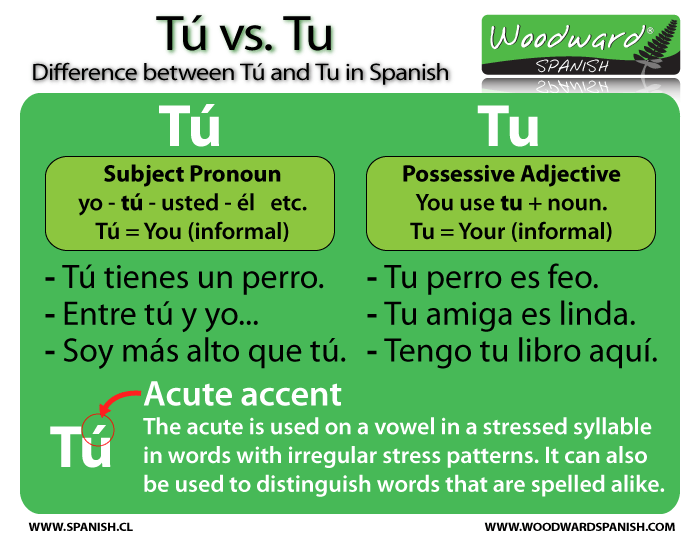Tú vs Tu
Common Mistakes in Spanish
The words Tú and Tu in Spanish frequently confuse English speakers. They are pronounced the same (homophones), are written a little differently but have completely different meanings.
When to use Tú
Tú is a subject pronoun (pronombre personal in Spanish).
Tú means You in English (informal you). Remember there are two ways of saying YOU in Spanish: Tú and Usted. Tú is informal and Usted is formal.
A) Tú can be used before a verb:
- Tú eres inteligente. (= You are intelligent)
- Tú hablas mucho. (= You speak a lot)
However note that when Tú is before a verb, it is often omitted since the ending of the verb (conjugation) makes it clear that we are referring to Tú (singular second person informal). So normally you will hear:
- Eres inteligente (without the tú at the beginning because eres makes it obvious it's referring to tú)
- Hablas mucho (without the tú at the beginning because hablas makes it obvious it's referring to tú)
B) Tú also comes after certain prepositions such as entre and según.
- Ya no hay nada entre tú y yo. (= There is no longer anything between you and I)
- Según tú, no es necesario. (= According to you, it's not necessary)
Remember that we normally use an object pronouns, not subject pronouns, after prepositions.
When to use Tu
A) Tu is a possessive adjective and goes before a noun. It shows possesion or that something belongs to someone.
- ¿Dónde está tu libro? (= Where is your book?)
- Me gusta tu sonrisa. (= I like your smile)
The acute accent
The acute accent is the little mark above a vowel in Spanish, in this case the letter U in Tú. The acute accent is used on a vowel in a stressed syllable in words with irregular patterns. It can also be used to distinguish words that are spelled alike though have different meanings or functions (as is this case).
Note, in informal writing you will sometimes see Tú (you) written without the accent mark (as in Tu). This is not really correct though happens a lot either because the writer was writing too quickly or maybe even because they don't know the correct grammar rules.
In Summary
Basically the difference can be summarized as:
Tú: (a personal pronoun) You (informal)
Tu: (possessive adjective) Your (informal)

TU vs. TÚ - Spanish Quiz
Next Activities
Try our interactive game online to practice the difference: Tú vs. Tu Game
If you found this Spanish Grammar Lesson about Tú vs Tu interesting or useful, let others know about it.

